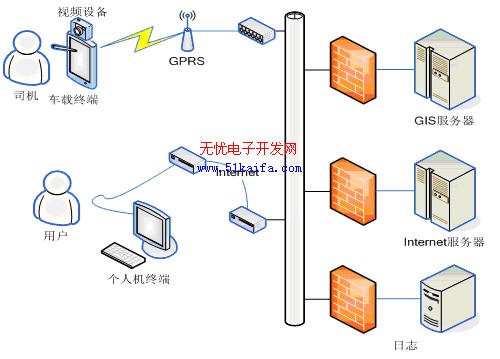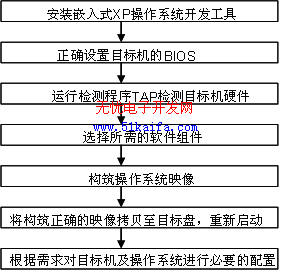0 Preface
This article refers to the address: http://
As a major component of intelligent transportation, car navigation and positioning has become a recent research hotspot [1]. With the change of global positioning system (GPS) from military to civilian, the application of GPS technology to the monitoring of mobile targets has other incomparable advantages. Therefore, the use of GPS technology to monitor and dispatch various vehicles has become a new research hotspot.
GPRS can realize real-time data exchange, and according to the data flow rate, it is especially suitable for the occasion of frequent small-flow data transmission of vehicle satellite positioning system. Therefore, the system uses GPRS as the communication method between the onboard computer and the server.
Since map matching uses complex algorithms, the topology of the road network must be in the database mode, and the entire positioning system must be implemented in high-level language programming. Based on these characteristics, the vehicle positioning device uses a single-board industrial computer as a hardware platform, and the operating system adopts Windows XP Embedded with SP2. Compared with other embedded operating systems such as Linux and Windows CE, the advantage of choosing embedded XP is that the existing program of the user side does not have to be reprogrammed, and the programmers of the developer are familiar with Windows-based programming, and do not have to learn new. How to program under the operating system.
With the development of network technology and people's demand for vehicle positioning, it is urgent to use the Internet to realize the positioning of the specified vehicle, so that the user can directly display the text to the user by accessing the website of the vehicle navigation and positioning company. Web GIS is a GIS that runs under the Internet environment. It is a new technology that uses Internet technology and to improve and extend traditional GIS functions. Therefore, how to use Web GIS technology combined with GPS technology to realize vehicle location query in the Internet environment is a problem worthy of discussion and has practical significance.
1 system's overall architecture
1.1 The composition of the system
In the vehicle positioning, the application system mainly includes the following four parts: a car GPS mobile terminal, a GPRS communication network, a vehicle service information center and a user, as shown in FIG. 1 .

Figure 1 system composition diagram
1. 2 working principle
The vehicle GPS mobile terminal can provide the service center with the latest positioning data of the moving target, the running speed and direction of the vehicle, and transmit the information to the vehicle service information center through the wireless communication network GPRS, and the vehicle service information center passes the wireless communication network GPRS. Communicate with the car GPS mobile unit and talk to the customer over the Internet. After the client submits the vehicle location request, the vehicle service information center receives the request and sends a positioning instruction to the in-vehicle mobile unit via the wireless communication network GPRS, and then transmits the latest information of the vehicle to the vehicle service information center, and the service information center receives the new one. The vehicle information is drawn on the map, and then the web page consisting of text and images is sent back to the client.
2 vehicle computer terminal hardware platform construction
The onboard computer terminal hardware platform uses AAEON's GENE-8310 development board as a platform, which is actually an embedded computer processing platform. Onboard Intel® Celeron® M 600MHz processor with powerful processing power. Has good display support and a rich interface. It is the best choice for customers with higher requirements such as excellent processing power under low power control. Especially because it is based on the Intel platform, software developed on a regular computer can run on the platform without modification. Simplified programming effort. On the basis of the development board, the GPS and GPRS modules are expanded to form a hardware system of the on-board computer terminal.
3 Development and construction of vehicle operating system [2]

Figure 2 Embedded XP operating system development process
The onboard computer terminal software platform uses Windows XP Embedded with SP2 as an operating system. Windows XP Embedded is a componentized version of the desktop Windows XP operating system that quickly develops the most reliable full-featured connectivity devices. Windows XP Embedded uses the same binary code as Windows XP Professional, enabling embedded developers to select only the rich customization features required for small coverage embedded devices. In this system, we chose 512M CF card as the carrier of the vehicle operating system and application software, and the operating system is controlled within 100M.
The development of a specific embedded XP operating system can be roughly divided into several steps, as shown in Figure 2. In view of the length, it will not be described in detail here.
4 GPS data reception and optimization processing
The GPS receiving module adopts TFAG30 of Flying Eagle Company, and the positioning information returned by the vehicle GPS mobile unit is NMEA0813 standard format data, wherein $GPGGA (header identifier), hhmmss. ss (time, hour, minute, second), bbbb , bbbb (latitude, degree, division), N (north latitude, s guide latitude), IIII, IIII (longitude, degree, division), E (east, w west) ),q (1 means positioning mode GPS, 2 means DGPS), nn (satellite number), P (horizontal position positioning accuracy factor), h, h (sea level antenna height), m., gg (ellipsoidal surface) Antenna high), m, xxx (for DGPS valid data period), aaaa (DGPS base station number), ss (checksum), <CR> carriage return
Since the received satellite data has ephemeris error, ionospheric error, tropospheric error and random noise, in order to improve the accuracy of positioning, the satellite positioning data needs to be processed by differential algorithm [4].
In order to eliminate the influence of random noise and dynamic noise on the positioning result, the positioning data should be filtered and smoothed before data processing. A description of the Kalman filtering method employed is given below.
(1), dynamic equation

Where, PRC is the corrected pseudorange; PRm is the measured pseudorange; a is the pseudorange weighting coefficient; Δr is the unweighted distance correction value; CPR is the pseudorange correction value measured by the base station; CPw is the pseudorange rate correction value measured by the base station; ti is the time for measuring the pseudorange; t0 is the reference time of the correction time; k is other error.
After differential processing, the data positioning accuracy can be guaranteed within 10m to meet the actual application requirements.
5 GPRS wireless link establishment
The GPRS wireless communication module adopts the MC35I of Siemens, and the establishment of the GPRS wireless communication link includes two processes of GPRS attachment and PDP context activation. The specific process is described as follows: (1) The in-vehicle system sends an AT command to the GPRS wireless communication module to request activation of the IP protocol, and the command includes the name of the APN access point to be connected, QOS and other parameters. (2) The mobile terminal sends an LCP data frame to the network for setup and parameter negotiation. After the parameter negotiation is completed, the user identity is confirmed through the PAP protocol, and the user ID and password are saved. (3) The mobile terminal sends an IPCP data frame, requests to dynamically allocate an IP address, and the SGSN sends an activation PDP context request. (4) The SGSN requests the DNS server to parse the APN to obtain the IP address of the GGSN corresponding to the APN. The SGSN sends a PDP context request to the selected GGSN, and the GGSN authenticates the user, and then assigns a dynamic IP address to the user, and then returns PDP context establishment success information to the SGSN. (5) The SGSN sends an activation PDP message to the mobile terminal, and responds to the IP address dynamically allocated by the mobile terminal through the IPCP configuration.
6 Design and Architecture of WebGIS System
The WebGIS system is built using Microsoft Visual Studio. NET 2003 + SQL Server 2000 + MapX. The data of the system mainly includes two kinds of spatial data and attribute data. The spatial data includes the following layers: administrative division, residential area, water system, road network, government, enterprise, hotel, and the above layer is in the Map X data set configuration file. Configured in Geoset Manager, saved as rpdh.gst file; attribute data is stored in SQL Server 2000, including user management table (user ID, user name, password, company name), vehicle information table (vehicle ID, belonging to user, car SIM) -ID, vehicle remark information) and reception information table (vehicle SIM-ID, longitude, latitude, speed, direction, time, etc.).
The WebGIS system architecture is mainly composed of two parts. Including the client and the server side, the client only needs the user to install the IE browser, wherein the client's ZoomView component implements a view change script. The server side mainly consists of a network server and a GIS WEB server. The network server needs to install Microsoft Asp.Net, which is responsible for the session with the client, and the GIS WEB server provides the GIS function.
The network server and the GIS WEB server use .NET Remoting technology to implement remote calling. The ActiveXMessenger component implements the message transfer function between the web server and the GIS WEB server. ActiveXIntermediator is a remote processing object and is also based on the core of .NET Remoting technology. , where ActiveXlntermediator runs on the GIS WEB server and runs its proxy object on the web server. The GIS WEB server acts as a server in remote calls, providing the functionality of ActiveX controls; the web server acts as a client in remote calls. The implementation of GIS WEB service WebGIS adopts the new Remoting[5] technology added in the .Net programming environment, including ActiveXBroker Group, ActiveXBroker, ActiveXServer and ActiveX components. ActiveXServer is a container of ActiveX object, an ActiveXServer contains an ActiveX object, ActiveX implements the corresponding ActiveX control function, ActiveXBroker is to initialize a certain number of ActiveXServer objects when the server service starts, so that each ActiveXServer object runs in a separate thread. Each of these ActiveXServer objects needs to run in a single-threaded apartment.
7, system functions and features
After the system is designed, it has the following functions: (1) Vehicle positioning function. (2) Track playback function. (3) Alarm function. (4) Functions such as zooming in, zooming out, roaming, and querying electronic maps.
Compared with similar products, the system has the following advantages: (1) The user is convenient to operate, the user only needs to be able to access the Internet, and then click on the vehicle that he wants to query, the vehicle is transmitted to the client as a webpage, and can grasp himself in real time. Have the location of the vehicle. (2) Platform independence, regardless of the server/client machine, regardless of the GIS software used by the Web GIS server, users can transparently access Web GIS data by using a common Web browser. (3) Using .NET programming technology and universal wintel platform, the technology is object-oriented, easy to reuse, brings convenience for system implementation and upgrade, and facilitates system expansion and secondary development.
8 Conclusion
Applying WebGIS technology to vehicle positioning to meet the needs of customers to query vehicles through the Internet, laid the foundation for vehicle navigation and scheduling in the Internet environment. The in-vehicle embedded platform is based on the universal wintel architecture, which facilitates the function expansion and upgrade of the in-vehicle system. Has a certain application prospects.
MA Series Switching Power Amplifier
Ma Series Switching Power Amplifier,Stereo Powerful Amplifier,Stereo Switch Amplifier
Line Array Speaker,MS Series Transformer Amplifier Co., Ltd. , http://www.nsspeakers.com